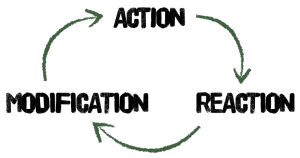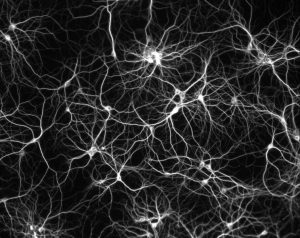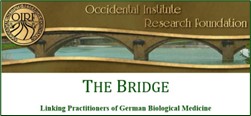The Causes of Illness &
Degenerative Diseases,
Part 2: Some Basic Principles
of Biological Regulation
The term homeostasis was first defined in 1932 by Walter Bradford Cannon. He created it by bringing together two Greek terms: homoios, which means “the same,” “like,” or “resembling,” and stasis, which means “standing,” “position,” or “posture.” Homeostasis, then, literally means “to remain in the same condition,” as close as possible to a steady state of the system.
Cannon’s book “The Wisdom of the Body” describes how the human body maintains steady levels of temperature and other vital conditions such as the water, salt, sugar, protein, fat, calcium, and oxygen contents of the blood. Similar processes dynamically maintain steady-state conditions in the Earth’s environment.
Homeostasis is the condition your body constantly strives to maintain.
You Are, in Fact, a Cyborg: The Human Body as a Cybernetic System
The human body is an extremely complex, unified, dynamic, homeostatic – or goal-seeking – system.
“Homeostatic ideas,” writes Kelvin Rodolfo, Emeritus Professor of Earth and Environmental Sciences at the University of Chicago, “are shared by the science of cybernetics (from the Greek for ‘steersman’),”
Defined in 1948 by the mathematician Norbert Wiener as “the entire field of control and communication theory, whether in the machine or in the animal.” Cybernetic systems can “remember” disturbances and thus are used in computer science to store and transmit information. Negative feedback is a central homeostatic and cybernetic concept, referring to how an organism or system automatically opposes any change imposed upon it.
So although these days we tend to think of cybernetics in terms of computers and technology, the human body is itself a cybernetic system. It receives input and responds to it. The response delivers more input, which in turn brings about different responses. It’s an endless feedback loop, all with one goal: maintain homeostasis.
 Let’s consider just one aspect of homeostasis: temperature regulation. On a very hot day, your body responds to that input – heat – by dilating your blood vessels so more blood flows near the skin’s surface where it can release heat. You also sweat to cool the skin. These processes help keep your internal body temperature at a steady level. And as it begins to cool off your body responds accordingly to that new input.
Let’s consider just one aspect of homeostasis: temperature regulation. On a very hot day, your body responds to that input – heat – by dilating your blood vessels so more blood flows near the skin’s surface where it can release heat. You also sweat to cool the skin. These processes help keep your internal body temperature at a steady level. And as it begins to cool off your body responds accordingly to that new input.
This is cybernetics in action. And it applies to all bodily regulation – not just temperature control, but blood sugar regulation, heart action, hormone release, and so on.
All this is coordinated through the brain, which can be viewed as a complex communication center, computer, and control system – a very complex system. In fact, it’s often been said [1] that there are as many neurons in the human brain as stars in the Milky Way.
For a long time, neuroscientists would say that there are about 100 billion neurons in the human brain. Interestingly, no one has ever published a peer-reviewed scientific paper supporting that count. Rather it’s been informally interpolated from other measurements. A recent study from 2009 published by Azevedo and colleagues took a crack at a more precise estimate. Their answer?
There are approximately 86 billion neurons in the human brain. The latest estimates for the number of stars in the Milky Way is somewhere between 200 and 400 billion. So close, but the human brain certainly doesn’t quite stack up!
Still, that’s a lot of neurons, and each is consistently interacting with millions of other cells in the body. That is the potential for 100 trillion interactions, a number 1,000 times greater than all the stars in the Milky Way!
 What’s really remarkable is the fact that your brain keeps all these bodily systems working together as a synchronized unit to create a smooth running system and maintain a steady homeostatic state. Properly maintained, this steady state can last for a human lifetime.
What’s really remarkable is the fact that your brain keeps all these bodily systems working together as a synchronized unit to create a smooth running system and maintain a steady homeostatic state. Properly maintained, this steady state can last for a human lifetime.
But life is dynamic, defined by continual change. Your body is sensitive to the smallest stimuli. To live is to be in constant interaction with your surrounding environment.
As Dr. Rodolfo suggests in his article on homeostasis, this dynamic is like driving a car, where we consider the “car and its driver as a unified…, ‘goal-seeking’ system – a cyborg or ‘cybernetic organism.’” It’s goal? Drive a road from point A to point B.
The driver does not steer by holding the wheel in a fixed position but keeps turning the wheel slightly to the left and right, seeking the wheel positions that will bring the naturally meandering car back on track. Disturbance, or departure from equilibrium, is every bit as important as negative feedback: Systems cannot correct themselves if they do not stray.
Oscillation is a common and necessary behavior of many systems. If the car skids, the driver automatically responds by quickly steering in the opposite direction. Such abrupt negative feedback, however, usually over-corrects, causing the car to move toward the other side of the road. A negative feedback, if it is as large as the disturbance that triggered it, may become an impressed change in the direction opposite to that of the original disturbance. The car and driver recovers from the skid by weaving from side to side, swerving a little less each time. In other words, each feedback is less than the last departure from the goal, so the oscillations ‘damp out.’ Negative feedback takes time and such a time lag is an essential feature of many natural systems. This may set the system to oscillating above and below the equilibrium level.
The human body and the environment form an extremely complex interacting unit that is always changing, influenced by any subtle stimuli in the environment. Even in nano concentrations, they have an immediate effect on the extracellular matrix (biological terrain), amplifying or inhibiting reactions through tiny dosages of cytokines and other steering mediators unleashed by the immune system.
The human body is continuously trying to correct these deviations to regain its steady and harmonious state. To do so, the bioregulatory system of the body directs, corrects, or manages most bodily processes using subtle quantities of mediators or oscillations which are directed by the extracellular matrix.
As we’ve noted before [2], this understanding originates in the work of Claude Bernard, who theorized that maintaining stability in the internal environment (milieu interieur) is a prerequisite for the development of a complex nervous system. His research on a multiple dynamic equilibrium is the basic principle behind homeostasis.
Considered one of the fathers of physiology, Bernard was so famous into the early 20th century that he became identified in the public mind as the archetypal scientist, much like Einstein is considered today.
Challenges to the Steady State
Each of us is continuously being influenced by both the environment around us, as well as the microenvironment within. The goal is to remain in a steady state – the state of health.
 And these days, it faces more challenges than ever. According to the Environmental Working Group [3], there more than 7 million chemicals in existence. About 80,000 of these are in common use around the world. They have brought enormous benefits – swelling harvests, beating back previously unconquerable diseases, producing a host of consumer goods we now think of as necessities – but at quite a cost [4].
And these days, it faces more challenges than ever. According to the Environmental Working Group [3], there more than 7 million chemicals in existence. About 80,000 of these are in common use around the world. They have brought enormous benefits – swelling harvests, beating back previously unconquerable diseases, producing a host of consumer goods we now think of as necessities – but at quite a cost [4].
Tests for a hundred particularly hazardous substances have revealed that – on average – we each harbor 27 of them in our blood, though the chemical cocktail varies from person to person. Children have been found to be more contaminated than their parents or grandparents, while mothers pass on the poisons to babies in the womb. Researchers have found potentially dangerous chemicals in every one of 14 basic foodstuffs they took from supermarket shelves, and in the air of every home they visited.
Findings like these spurred 200 eminent scientists from five continents some years ago to issue a joint warning that exposure to common chemicals skewed the development of critical organs in fetuses and newborns, increasing their chances of developing diabetes, cancer, attention deficit disorders, thyroid damage, diminished fertility, and other conditions in later life.
The Standing Committee of European Doctors – which brings together the continent’s top physicians’ bodies, including the BMA – has added: “Chemical pollution represents a serious threat to children, and to Man’s survival.” And the usually cautious US President’s Cancer Panel has reported that synthetic chemicals can cause “grievous harm” and that the number of cancers for which they are responsible had been “grossly underestimated”.
In yet another warning, researchers from the Mount Sinai School of Medicine in New York and the University of Southern Denmark predicted a “silent pandemic” of brain conditions such as autism, cerebral palsy and attention deficit disorders, identifying 202 substances known to poison the brain as “the tip of a very large iceberg”.
Your body responds to every exposure – not just to chemicals but toxins of all kinds, synthetic and organic – even miniscule amounts that public officials often say pose no risk to human health. But many accumulate over time, and they interact in ways we’re only just beginning to understand, as researchers look at the cumulative effects of the chemical cocktail we’re exposed to daily.
This can – and does – have profound implications on your body’s self-regulating abilities. And that is a matter we will pick up with next time in the final installment of this series.
Neural network image by Else If Then [5], via Wikimedia Commons
Article reprinted from Gary M. Verigin, DDS, Inc.: http://biologicaldentalhealth.com
 A Reprinted Article for OIRF Supporters
A Reprinted Article for OIRF Supporters
From THE BRIDGE Newsletter of OIRF
Published August 2017
© Copyright 2016, Dr. Gary M. Verigin, CA USA
From an article in Dr. Verigin’s Biosis Newsletter, Summer 2017, Issue #55
Note from OIRF: Dr. Verigin has now retired, and many of the following links are not functional at this time.
URLs in this post:
- it’s often been said: https://www.nature.com/scitable/blog/brain-metrics/are_there_really_as_many
- before: http://biologicaldentalhealth.com/true-healing-can-begin-improving-state-terrain/
- According to the Environmental Working Group: http://www.chemicalindustryarchives.org/factfiction/testing.asp
- but at quite a cost: http://www.telegraph.co.uk/news/earth/countryside/8985039/Human-bodies-contain-too-many-damaging-chemicals.html
- Else If Then: https://commons.wikimedia.org/wiki/File:R%C3%A9seau_de_neurones.jpg
- Facebook: http://biologicaldentalhealth.com/some-basic-principles-of-biological-regulation/?share=facebook
- Twitter: http://biologicaldentalhealth.com/some-basic-principles-of-biological-regulation/?share=twitter
- Pinterest: http://biologicaldentalhealth.com/some-basic-principles-of-biological-regulation/?share=pinterest
- LinkedIn: http://biologicaldentalhealth.com/some-basic-principles-of-biological-regulation/?share=linkedin
- Reddit: http://biologicaldentalhealth.com/some-basic-principles-of-biological-regulation/?share=reddit
- Google: http://biologicaldentalhealth.com/some-basic-principles-of-biological-regulation/?share=google-plus-1



